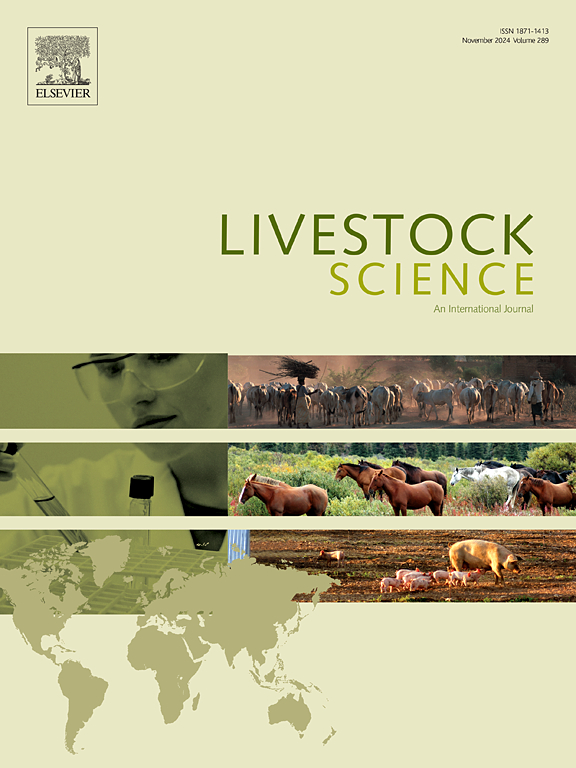Comparison of country-specific predictions of feed intake and methane emissions in sheep using different proxies
IF 1.9
3区 农林科学
Q2 AGRICULTURE, DAIRY & ANIMAL SCIENCE
引用次数: 0
Abstract
Ruminants are often singled out as being the main culprits when it comes to greenhouse gas (GHG) emissions, for methane (CH4) in particular. However, with their diets based on forage and grazing, ruminants have a role to play to limit the feed-food competition. Sheep breeders are open to the prospect of including both feed efficiency and GHG emissions in their breeding programmes and whether or not it is for the purpose of genetic (or genomic) selection, the acquisition of new phenotypes for feed efficiency and GHG emissions are essential. Currently, devices recording GHG emissions and individual feed intake of animals reared indoors remains too expensive for most sheep breeders worldwide. In this study, research groups from six countries (UK (Scotland), France, Norway, Ireland, New Zealand and Uruguay) gathered their results obtained in different breeds to identify the most promising proxy measurements of feed intake and methane emissions. Despite the fact that each group set up their own protocol, there were several points in common: most feed intake trials were performed during 6 weeks on growing animals, and GHG emissions were all recorded with portable accumulation chambers (PACs). Different traits, in addition to feed intake and GHG emissions, were recorded and considered as putative proxies (body composition, growth, bodyweight, feeding behaviour, body condition score), as well as sheep genotypes and ruminal microbiota. Models' goodness of fit were estimated on training sets, whereas their prediction accuracy was assessed on actual validation datasets. The comparison of training and validation accuracies obtained with each dataset highlighted the well-documented problem of overfitting, particularly with microbiota data. In general, validation prediction accuracies were higher for feed intake than for the two feed efficiency criteria (residual feed intake and feed conversion ratio) investigated. The best predictions for feed intake were obtained when body weight and the average number of feeding events per day were included in the models (R²valid=0.78). Methane emissions were predicted with the highest accuracy when feed intake was considered among the proxies. Prediction accuracies for methane emissions obtained with the metagenome were higher than with sheep genome, although this accuracy remains quite low (Rvalid=0.32).
By comparing independent results from six countries, we highlighted that the recording of body weights, feeding behaviour and fixed effects are crucial for the prediction of feed intake. However, feed efficiency and methane emissions are relatively difficult to predict well, with the proxy measurements assessed here.
使用不同代用物对绵羊采食量和甲烷排放的国别预测进行比较
反刍动物经常被认为是温室气体(GHG)排放的罪魁祸首,尤其是甲烷(CH4)。然而,由于它们的饮食以饲料和放牧为基础,反刍动物在限制饲料-食物竞争方面可以发挥作用。绵羊育种者对将饲料效率和温室气体排放纳入其育种计划的前景持开放态度,无论是否出于遗传(或基因组)选择的目的,获得饲料效率和温室气体排放的新表型都是必不可少的。目前,对世界上大多数绵羊饲养者来说,记录温室气体排放和室内饲养动物个体采食量的设备仍然过于昂贵。在这项研究中,来自六个国家(英国(苏格兰)、法国、挪威、爱尔兰、新西兰和乌拉圭)的研究小组收集了他们在不同品种中获得的结果,以确定最有希望的采食量和甲烷排放的替代测量方法。尽管每个小组都制定了自己的方案,但有几个共同点:大多数采食量试验都是在6周内对生长动物进行的,温室气体排放都是用便携式积累箱(PACs)记录的。除了采食量和温室气体排放外,还记录了不同的性状(体组成、生长、体重、摄食行为、体况评分)以及羊的基因型和瘤胃微生物群。模型的拟合优度是在训练集上估计的,而其预测精度是在实际验证数据集上评估的。每个数据集获得的训练和验证精度的比较突出了有充分记录的过拟合问题,特别是微生物群数据。总的来说,采食量的验证预测精度高于所研究的两种饲料效率标准(剩余采食量和饲料转化率)。当模型中包括体重和平均日采食事件数时,采食量预测最佳(R²有效=0.78)。考虑采食量时,甲烷排放量的预测精度最高。宏基因组对甲烷排放的预测精度高于绵羊基因组,尽管准确度仍然很低(Rvalid=0.32)。通过比较来自六个国家的独立结果,我们强调了体重、摄食行为和固定效应的记录对于预测采食量至关重要。然而,饲料效率和甲烷排放相对难以很好地预测,这里评估了代理测量。
本文章由计算机程序翻译,如有差异,请以英文原文为准。
求助全文
约1分钟内获得全文
求助全文
来源期刊

Livestock Science
农林科学-奶制品与动物科学
CiteScore
4.30
自引率
5.60%
发文量
237
审稿时长
3 months
期刊介绍:
Livestock Science promotes the sound development of the livestock sector by publishing original, peer-reviewed research and review articles covering all aspects of this broad field. The journal welcomes submissions on the avant-garde areas of animal genetics, breeding, growth, reproduction, nutrition, physiology, and behaviour in addition to genetic resources, welfare, ethics, health, management and production systems. The high-quality content of this journal reflects the truly international nature of this broad area of research.
 求助内容:
求助内容: 应助结果提醒方式:
应助结果提醒方式:


